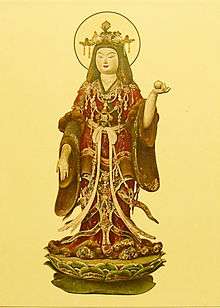Kisshōten

Kisshōten (吉祥天), also known as Kichijōten, Kisshoutennyo (吉祥天女), Kudokuten (功徳天) is a Japanese female deity. Adapted via Buddhism from the Hindu goddess Lakshmi [and absorbing traits of the god Krishna] Kisshoutennyo is sometimes named as one of the Seven Gods of Fortune (fukujin), replacing either Jurōjin or Fukurokuju.[1] For example, in the 1783 edition of the Butsuzōzui compendium (reprinted in 1796), Kichijōten replaces Fukurokuju as one of the seven fukujin.[2] She is considered to be the goddess of happiness, fertility, and beauty.[1][3] Kisshoutennyo's iconography is distinguished by the Nyoihōju gem (如意宝珠) in her hand.
When Kisshoutennyo is counted among the seven fukujin[2] and fellow fukujin Daikoku is regarded in feminine form,[4] all three of the Hindu Tridevi goddesses are represented in the fukujin.
See also
- Kisshō Tennyo (manga)
- Nyoihōju (如意宝珠) wishing gem
- Fukujin (福神) deities
- Buddhist Tenbu (天部) deities
- Hinduism in Japan
References
- 1 2 "Wooden figure of Kichijōten". The British Museum. Retrieved 27 August 2012.
- 1 2 "Butsuzōzui (Illustrated Compendium of Buddhist Images)" (digital photos) (in Japanese). Ehime University Library. 1796. p. (077.jpg).
- ↑ "Kisshōten (Kichijōten)". Philadelphia Museum of Art. Retrieved 27 August 2012.
- ↑ "Butsuzōzui (Illustrated Compendium of Buddhist Images)" (digital photos) (in Japanese). Ehime University Library. 1796. p. (059.jpg).
| Wikimedia Commons has media related to Kichijouten. |


